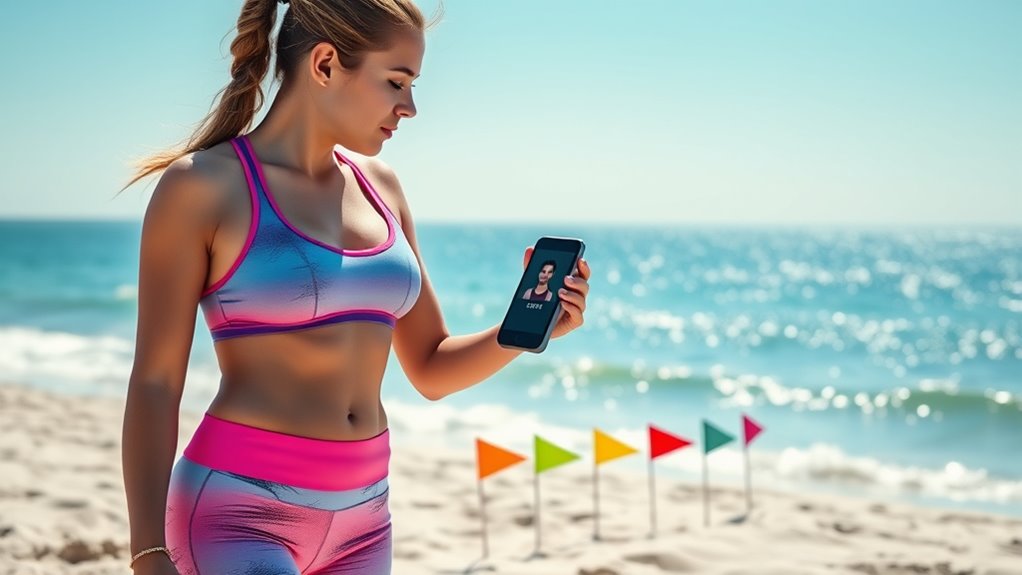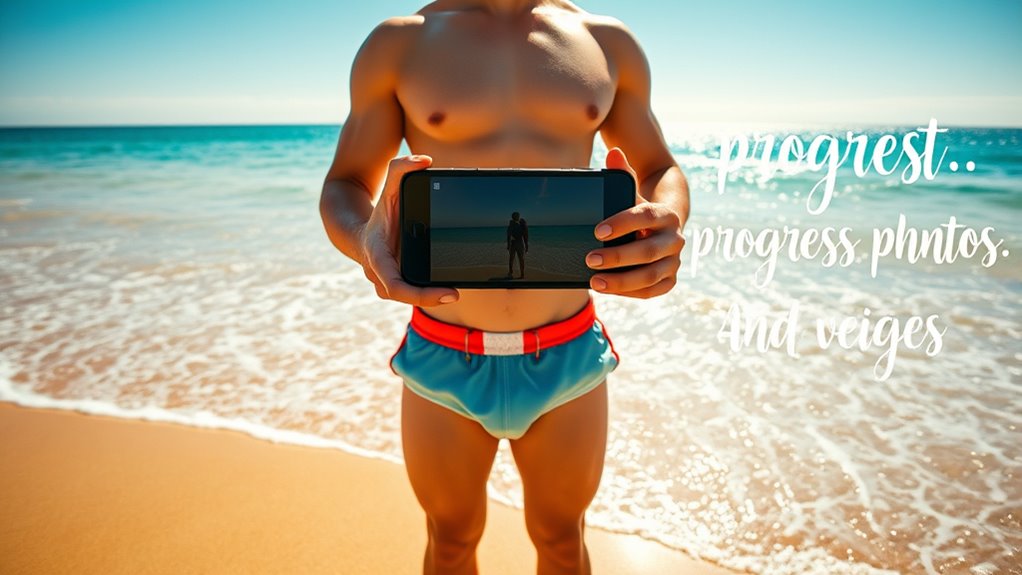To track your beach body progress, set clear, measurable goals and break them into milestones. Take consistent photos from multiple angles with good lighting, and regularly measure key body areas and body fat percentage. Keep a detailed log of workouts and meals, and notice how your clothes fit and perform. Tracking these indicators helps you see real changes, keeping motivation high. If you keep following these steps, you’ll find even more effective ways to stay on course.
Key Takeaways
- Take regular progress photos from multiple angles with consistent lighting and clothing.
- Measure key body parts and record changes to track physical transformation.
- Monitor body weight and body fat percentage to assess overall progress.
- Keep a workout and nutrition log to evaluate routine effectiveness and dietary habits.
- Observe how clothes fit and note performance improvements for practical progress indicators.
Set Clear Goals and Milestones

To effectively track your beach body progress, you need to set clear goals and milestones from the start. Define specific, measurable outcomes like losing a certain number of pounds, reducing body fat percentage, or fitting into a particular swimsuit size. Break these big goals into smaller milestones so you can celebrate progress along the way. For example, aim to lose five pounds first or improve your endurance for a 5K run. Writing down your goals keeps you accountable and focused. Make sure your goals are realistic and time-bound to stay motivated. Tracking these milestones regularly helps you see how far you’ve come and adjust your plan if needed. Setting achievable goals keeps you motivated and prevents discouragement. Clear goals give you direction and a sense of purpose throughout your fitness journey. Incorporating aesthetic organization techniques in your workout space can also improve motivation and maintain your focus. Additionally, understanding the science behind body composition changes can help you tailor your efforts for more effective results. For instance, monitoring your progress with a home theatre projector can make your workouts more engaging and enjoyable, encouraging consistency. Recognizing the importance of family photoshoot fails reminds us that progress can be fun and unpredictable, encouraging a positive mindset throughout your journey.
Use Photos to Visualize Progress

Taking photos of your body at regular intervals offers a powerful way to see changes that might not be obvious day to day. Unlike relying solely on the mirror, photos provide a visual record you can compare over time. To get the most accurate view, take pictures from consistent angles—front, side, and back—using similar lighting and clothing. Wear fitted clothing or swimwear that reveals your progress clearly. Don’t stress about perfection; focus on capturing honest images to track subtle shifts in muscle tone, posture, and body shape. Incorporating visual progress tracking into your routine can enhance your motivation and help you recognize improvements more effectively. Using visual documentation can also provide motivation by showing tangible results of your efforts. Regularly updating these images allows you to notice gradual body composition changes that may not be immediately visible. Reviewing these photos regularly helps you stay motivated and recognize progress that might otherwise go unnoticed. Over time, these visuals serve as a tangible reminder of your hard work and dedication. Additionally, consistent photo documentation can help identify areas that may need extra focus in your fitness journey. Implementing this method aligns with the importance of AI in entertainment to track and analyze data effectively.
Track Measurements and Body Stats

Tracking your measurements and body stats provides concrete data to gauge your progress beyond visual changes. Regularly measuring areas like your waist, hips, chest, arms, and thighs helps you see where your efforts are making an impact. Use a flexible tape measure for accuracy, and record your numbers consistently—ideally weekly or biweekly. Don’t forget to track your body fat percentage and weight with a reliable scale or device. Keep a dedicated journal or app to log your stats, making it easier to spot trends over time. Remember, progress isn’t just about weight loss; improvements in muscle tone and body composition matter too. Staying consistent with measurements keeps you motivated and helps you adjust your plan as needed. Incorporating body composition assessments can provide a more comprehensive view of your overall health and fitness. Recognizing the importance of a balanced approach, as highlighted in fatherhood quotes, can inspire you to stay committed to your fitness journey. Additionally, utilizing accurate measurement tools ensures your tracking remains precise and trustworthy. Using standardized methods for measuring can improve the reliability of your progress tracking and reduce errors. Tracking your progress with consistent methods helps maintain motivation and ensures your results are reliable.
Keep a Workout and Nutrition Log

Keeping a workout and nutrition log is essential for staying accountable and understanding what’s working best for your body. When you record your exercises, reps, and sets, you can see your progress over time and adjust your routine as needed. Tracking your meals helps identify patterns, such as which foods boost your energy or hinder your results. Use a notebook, app, or spreadsheet—whatever suits your style. Be consistent by logging every workout and meal, even on rest days. This habit keeps you motivated and focused on your goals. Plus, it highlights small improvements that might go unnoticed otherwise. Over time, your log becomes a valuable tool for refining your plan, ensuring you stay on track toward achieving your beach body.
Monitor How Your Clothes Fit and Performance

Noticing how your clothes fit can provide immediate feedback on your progress that logs alone might miss. If your jeans feel looser or your shirts sit differently, it’s a clear sign you’re moving in the right direction. Pay attention to both comfort and fit, as they reflect changes in your body composition and muscle tone. To track this effectively, compare how different clothes fit over time. Use the table below to record your observations:
| Clothing Item | Fit Changes | Performance Notes |
|---|---|---|
| Jeans | Looser waist | Easier to move in |
| T-Shirt | Less tight | Increased comfort |
| Shorts | Less restrictive | Improved endurance |
| Dress | Slightly looser | Better posture |
Monitoring these cues helps you stay motivated and aware of subtle progress that might otherwise go unnoticed. Paying attention to bodily changes can further enhance your awareness of progress beyond just clothing fit.
Frequently Asked Questions
How Often Should I Update My Progress Tracking?
You might wonder how often to update your progress tracking. To stay motivated without feeling overwhelmed, aim for weekly updates. This allows you to notice changes without obsessing over daily fluctuations. Consistent tracking helps you identify trends and make adjustments. Remember, everyone’s different—so find a rhythm that works for you. Regular updates keep you accountable and give you clear insights into your journey toward your beach body goal.
What Are the Best Tools for Tracking Body Measurements?
You want to know the best tools for tracking body measurements. Using a flexible measuring tape is essential, as it’s accurate and easy to use. You can also consider digital tools like body measurement apps or smart scales that sync with your phone. Keep a dedicated journal or digital file to record your measurements regularly. Combining these tools helps you see progress clearly and stay motivated on your fitness journey.
How Do I Stay Motivated During Long Tracking Periods?
Staying motivated during long tracking periods can be tough, but you can do it by setting small, achievable goals that keep you focused. Celebrate your progress, no matter how minor, to boost your confidence. Remember why you started and visualize your end goal. Keep things fun by trying new workouts or healthy recipes. Surround yourself with supportive people, and don’t forget to reward yourself for your dedication along the way.
Can Progress Be Accurately Measured Without a Scale?
You can definitely measure progress without a scale. Focus on visual changes in your body, how your clothes fit, and your strength or endurance levels. Take weekly photos from multiple angles to notice subtle shifts. Track your measurements of key areas like hips, waist, and arms. Remember, progress isn’t just about weight; improvements in energy, confidence, and overall fitness also show you’re heading in the right direction.
What Should I Do if I Hit a Plateau?
Imagine you’re climbing a mountain, and suddenly, the trail flattens. That’s a plateau. When you hit one, switch up your routine—try new exercises, increase intensity, or adjust your diet. Keep pushing forward, just like finding a new path up the mountain. Stay consistent, be patient, and remember, plateaus are just pauses before your next breakthrough. Stay motivated, and you’ll reach the summit!
Conclusion
By tracking your beach body progress, you’re like a captain steering your own ship — each step bringing you closer to your destination. Keep setting goals, snapping photos, and monitoring your stats to stay motivated on this journey. Remember, progress isn’t just about looks; it’s about how you feel and perform. Stay consistent, and you’ll soon see your transformation unfold like the sunrise on a clear morning, brightening your confidence every day.










